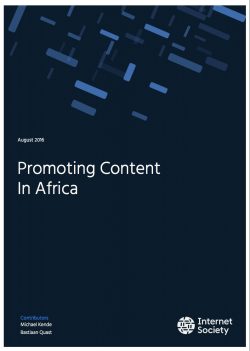While there are a lot of improvements when it comes to the infrastructure needed to make the Internet work, people across Africa still aren’t logging on. Why? Because people don’t see a reason to.
According to a new study, content – and the language it’s in how relevant it is to people’s lives – are some of the latest challenges in bringing Africa fully online.
“Promoting Content in Africa” outlines the barriers to the development of local content and offers ways to help.
Ghanaian app developer and Internet Society member Divine Puplampu talks about some of the challenges.
Executive Summary
The vision of the Internet Society is that the Internet is for everyone, everywhere, and to help achieve this aim we have conducted a number of studies of barriers to connectivity in emerging regions. This report continues in that vein, but represents a shift from examining the barriers to accessing content. As a starting point we note that, as a result of new investments in access infrastructure including notably mobile Internet networks, Internet availability now far outpaces adoption, and raises the question of why adoption is lagging behind.
Sub-Saharan Africa has seen great improvements in connectivity infrastructure and affordability in recent years. In spite of this, the growth in Internet adoption is stagnating. This report starts from the general premise that a greater emphasis on the demand for Internet connectivity is required to increase adoption rates. Specifically, the report focusses on a number of areas that need to be addressed in order to facilitate local content availability and content distribution.
Content availability. As we are increasingly seeing, the ability to access the Internet is necessary, but not sufficient, to increase Internet adoption in a country; it is a means to an end, which is the content and services that people use when they are online. Much of the international content and services is relevant in many countries worldwide – this is true of social networking services, educational access, and, of course, entertainment. However, we also note the importance of locally created content given the relevance of the content in the local context.
Content must be in familiar languages, which is often an issue in Sub-Saharan countries whose populations are not always comfortable in the official government language. While one might assume this mainly impacts international content, it is also true for local content, including e-government services, as not everyone speaks the government language. Content availability may further be limited by legal restrictions on content that impact the willingness of international providers and platforms to make content available in a country, along with local developers who may self-censor their output to keep in line with legal restrictions.
At the same time, payment mechanisms are critical for both international and locally developed content. With a lack of a payment mechanisms users may not be able to purchase content, and even if they could, the developer may not be able to receive the payments. Such restrictions extend further to an ability to receive payments for advertising and for local entrepreneurs to raise funds to develop new innovations.
Coming full circle, the problems with advertising payouts are further aggravated by the fact that most major advertising platforms do not support any African languages (except Arabic), furthermore, in some cases even the placing of ads in a supported language (such as English or French) on pages that are primarily in a different language (e.g. Swahili) is expressly forbidden.
These problems are exacerbated by a lack of local infrastructure to distribute local content and lower the cost and time to access the content.
Content distribution. For all developing countries we have studied, the majority of content – both international and locally developed, is hosted outside the country, typically overseas. For instance, in Rwanda, for all .RW websites, only a very small fraction are hosted in Rwanda, and the rest are hosted predominantly in Europe and the US. Based on work that we did recently in Rwanda, overseas hosting can have a significant impact on the cost and latency of accessing the content, which acts to depress usage. Thus, having good local and regional content distribution platforms can significantly increase the usage of available content.
Three key levels of infrastructure are discussed. First, data centres provide a location where servers be securely operated. Second, a data centre can serve local hosting of content, but also international content through Content Delivery Networks. Third, in order to make sure no connections between content demand and supply are needlessly routed abroad, an Internet Exchange Point is needed to arrange local traffic flows.
Barriers for such infrastructure include training of engineers locally to operate the equipment, legal restrictions on those who host the content of others, access to power and fibre cables within the country, and import procedures that raise the time and cost of acquiring the equipment needed.
Removing barriers to build and operate these pieces of infrastructure can increase the amount of domestically available content. As the content is closer to the users, this lowers latency. In addition, ISPs do not have to spend money on submarine cable capacity to bring the content from overseas every time it is viewed. Eventually, prices for Internet access could be reduced.
Summary. We believe that this focus on removing barriers to content availability and distribution will have significant impacts on the Internet ecosystem. It will help to make existing international content more accessible, while also providing more opportunities for local entrepreneurs to identify and meet gaps in their markets, helping also to create income and jobs. Ultimately, it will help to increase demand for the Internet, bringing new users online and increasing the usage of those already online as they find new content and services to capture their interest, for social, business, and government uses.
